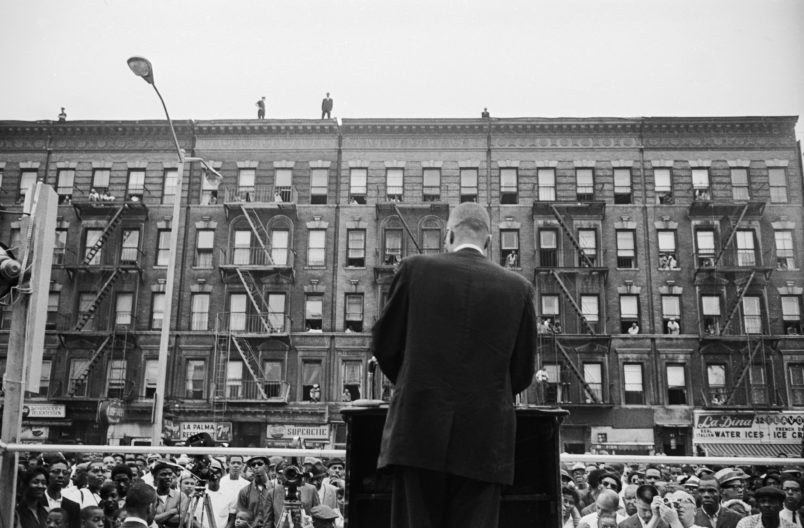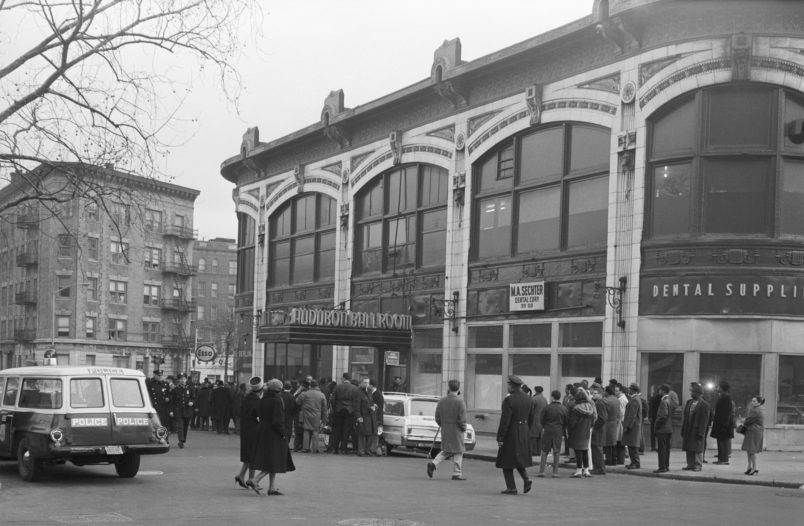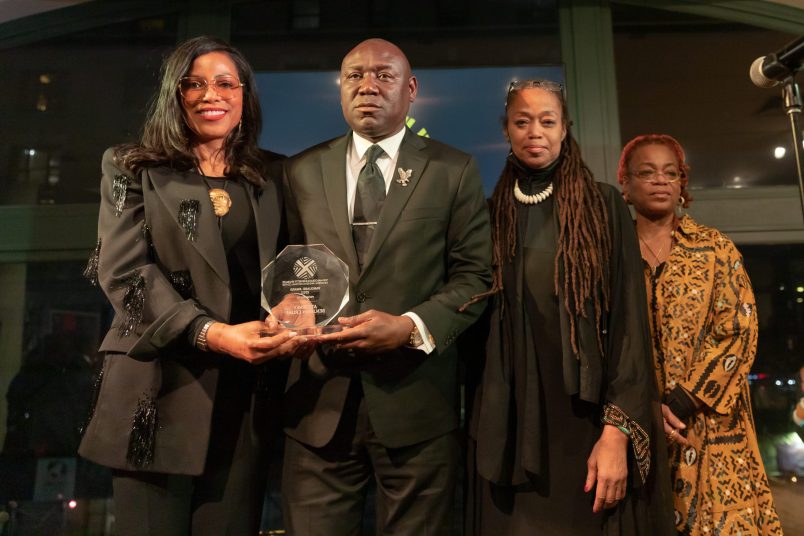A planned lawsuit from the family of slain civil rights leader Malcolm X follows decades of trauma and lingering questions for his daughters. The $100 million wrongful death suit was announced on Tuesday by attorney Ben Crump, who said he was providing “formal notice” to the City and State of New York, the FBI, and the CIA, as well as other federal agencies.
“For this great injustice, we will be filing a wrongful death lawsuit against these governmental entities for $100 million on behalf of his daughters that are coming forward,” Crump said. “But there is no measure of money, there is no measure of explanation that they could ever offer this family. The only thing they can do is try to right a historic wrong, not just for his family, but for his people and this world. We have to right this historic wrong.”
Malcolm X was shot and killed on February 21, 1965 at the Audubon Ballroom in New York City. Multiple gunmen were involved in the assassination. Three men were arrested and convicted of taking part. Two of them have since been exonerated.
Crump announced the lawsuit at The Malcolm X & Dr. Betty Shabazz Memorial and Educational Center, which is inside the former ballroom. Crump was flanked by two of Malcolm X’s daughters, Ilyasah and Qubilah Shabazz, who would be among the plaintiffs in the suit.
Qubilah, who has rarely spoken to the press, did speak with me in 2010 as I was completing a Columbia University School of Journalism master’s thesis project on the assassination. She discussed the experience of losing her father and her persistent belief that a government conspiracy was behind his death.
“I have never gotten over it. My father loved me and that was taken from me. My life was a total nightmare after he died,” Qubilah said in an interview for the project, which has not previously been published outside of the university.
During a brief telephone conversation conducted during the 2010 research project, another one of Malcolm X’s daughters, Gamilah Shabazz, who Crump also identified as one of the plaintiffs, suggested she too believed there were larger forces behind her father’s death before declining to comment further.
“You know, it was an international conspiracy,” Gamilah said.
Ilyasah Shabazz, another one of Malcolm X’s daughters who is bringing the suit, is the only member of his family who spoke at Crump’s press conference. Her family is looking for “the truth” and to put an end to their “unanswered questions,” she said.
“We want justice served for our father,” said Ilyasah, who did not immediately respond to an interview request for this story.
Qubilah, who was four years old when her father was killed, said during her 2010 interview with me that she “blocked out a lot” for a year or two after his death and “didn’t cry for a few years” until seeing a photo of his body brought the memories flooding back.
“My father was the soft, caring, playful parent… my father never gave us speeches at home, he gave us love,” Qubilah said. “When he died, that was all gone.”
Qubilah declined to comment on record for this story. Gamilah could not be reached.

It’s Not Just About The Triggermen
There are extensive questions about Malcolm X’s killing. Only one man, who was named Talmadge Hayer, has admitted to shooting Malcolm X. Hayer, who later became known as Mujahid Halim, was arrested at the scene of the crime after being shot in the thigh by one of Malcolm X’s bodyguards. Over the years, witnesses have offered conflicting accounts of what happened that day, stating that there were anywhere from three to five people involved in the shooting.
Two other men, Norman 3X Butler and Thomas 15X Johnson, were convicted along with Hayer in 1966 and subsequently sentenced to life in prison. All three men were members of the Nation of Islam, a Black Muslim group that Malcolm X helped lead in the first years of his political career. Both Butler and Johnson consistently maintained their innocence, but they were not released from prison until the 1980s. Hayer, who was paroled in 2010, confessed to taking part in the killing. However, he said on multiple occasions that the other two men convicted alongside him were innocent and claimed he had four other accomplices.
In November 2021, following a joint investigation conducted by the Manhattan District Attorney’s Office and lawyers for the two men, Butler and Johnson, who are now known as Muhammad Abdul Aziz and Khalil Islam, had their convictions thrown out. Former Manhattan District Attorney Cy Vance launched the investigation after a Netflix documentary series released between 2019 and 2020 explored the case. According to the New York Times, investigators ultimately determined prosecutors, the Federal Bureau of Investigation, and the New York City Police Department withheld exculpatory evidence and “failed to disclose the presence of undercover officers in the ballroom at the time of the shooting.”
At the press conference announcing the lawsuit, Crump said it was prompted by the exonerations. Crump, who did not immediately respond to requests for comment on this story, also suggested he has uncovered further evidence.
“The district attorney’s office in the city … admitted that these gentlemen were wrongfully convicted and that there was exculpatory evidence that would have exonerated them that they did not release or reveal,” Crump said. “There are many things that will be put forth in our lawsuit that speaks to this factual evidence, things that many people have speculated over the decades, but were not substantiated. We believe that now it could be substantiated based on the recent exonerations.”
Crump, who has become a prominent civil rights leader in his own right while seeking civil judgments for Black people in high profile cases of alleged injustice, also said his team will use the suit to pursue more new evidence.
“We plan on taking depositions of many of the figures that were involved — either rightfully or wrongfully — in the assassination of Malcolm X. It’s not just about the triggermen. It’s also about those who conspired with the triggermen to do this dastardly deed that killed that 39-year-old young father,” Crump said, later adding, “We believe we’ll be able with the force of law to subpoena and depose any individual that has relevant information. That’s what has never happened in the aftermath of the assassination of Malcolm X.”
In response to a question from a reporter, Crump said he believed government agencies were involved in Malcolm X’s death.
“The conspiracy included many, many individuals and many, many government entities … and many affiliates of those agencies,” Crump said.
Crump specifically named the FBI and its former director J. Edgar Hoover, who spearheaded aggressive efforts to surveil and sabotage civil rights activists. Malcolm X’s FBI file, which has been partially declassified, shows that, during his life, Malcolm X was monitored by the bureau and a slew of other government agencies including the Central Intelligence Agency, the State Department, Army, Air Force, and Naval Intelligence Units, the Department of Justice, the Secret Service, and several local police departments including the NYPD.

Staring At The Fire
Malcolm X was killed shortly after a bitter break with his former allies in the Nation of Islam. In his autobiography, which was originally published in the year before his death, Malcolm X wrote about how he was a “hustler” as a young man. He described selling drugs and engaging in burglaries. He joined the Nation of Islam during a stint in prison between 1946 and 1952. Upon his release, he rose to become one of the top evangelists for the religion, which blended the Koran and Black nationalist ideology. However, by the late 1950s, Malcolm X began to drift apart from the Nation of Islam’s leader, Elijah Muhammad.
In March 1964, Malcolm X formally broke away from the Nation of Islam. He went on to found two organizations of his own: Muslim Mosque Incorporated and the Organization of Afro-American Unity. MMI was a religious organization while the OAAU was focused on self-defense programs and presenting the concerns of Black Americans in front of the United Nations. The 11 months between Malcolm X’s departure from the Nation of Islam and his death were marked by constant and escalating infighting between his allies and Elijah Muhammad’s inner circle. Both Muhammad and Malcolm X claimed the other threatened their life through intermediaries.
On February 14, 1965, a week before his death, the threats turned to violence. Unidentified assailants threw a molotov cocktail at Malcolm X’s home in Queens, New York while he and his family slept. Quibilah Shabazz told me she was awoken by the blaze.
“I woke up because I’m hot, and I open my eyes, and there are flames coming through the window,” she said.
“I thought it was kind of neat to see fire flying through the window, and as I’m staring at the fire, some sparks hit me in the left eye and that’s when I decided to call for my father,” Qubilah recounted.
According to Qubilah, Malcolm, who was wearing “his long johns,” grabbed his family and his rifle and ran out into the driveway. As his wife and daughters fled to a neighbor’s house, Qubilah said Malcolm kept watch outside, gun in hand.
“If that Molotov cocktail had gone through the window rather than hitting my house and dropping, it would have hit my bed,” said Qubilah.
In the week following the firebombing, Malcolm X’s wife, Betty Shabazz, who was pregnant, and her daughters stayed with family friends. Malcolm X moved between hotels to avoid detection.
On the day Malcolm X was shot, he appeared at an OAAU rally at the Audubon. Due to the explosive climate, women and children were advised not to come to the Audubon rally. However, Qubilah Shabazz said that, shortly before he was due to appear, Malcolm called his wife, Betty, and asked her to bring the other four children to see him speak. Qubilah isn’t sure why he made this last-minute request.
“No one knows why he changed his mind,” said Qubilah. “He probably wanted to see his family one last time.”
Malcolm X’s wife and daughters were sitting in the ballroom when the shots rang out.
“It was total mayhem,” Qubilah said, “I can remember there being chairs knocked over, people rushing to get out of there.”
Policemen who were stationed across the street at Presbyterian Hospital did not secure the scene, even as Malcolm X’s bodyguards implored them to stop the assassins from escaping. Despite the large crowd, NYPD officers only took three witness statements.

In July 1995, Qubilah was arrested and charged with attempting to hire a hitman to kill Louis Farrakhan, who was one of Elijah Muhammad’s top lieutenants and now heads the Nation of Islam. Qubilah maintained the government was trying to frame her. Farrakhan, who has apologized to Malcolm X’s family for contributing to the volatile climate that led to Malcolm X’s death, supported Qubilah’s defense. Farrakhan’s position and the government’s reliance on a criminal informant led to the charges against Quibilah being dropped.
For her part, in the 2010 interviews, Qubilah said she believed “the government” was “behind” her father’s killing. However, she also suspected the people who wanted Malcolm X dead had help from inside of his inner circle.
“I want to know who actually facilitated it,” Qubilah said at the time.
While she and her sisters have deep questions about the circumstances of her father’s killing, as of 2010, Qubilah doubted she would ever get answers.
“I can’t see that there will ever be any closure on this. The powers that be, I think they believed my father got what he deserved,” Qubilah said, later adding, “Justice has definitely not been done.”
Now, after more than half a century, that may be about to change.



